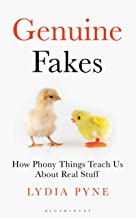“Only God Can Make a Diamond” makes a good advertising slogan, but it’s no longer true. Now diamonds can be made in a laboratory (https://en.wikipedia.org/wiki/Synthetic_diamond). But should synthetic diamonds be considered real? How many romances have broken up because the diamond wasn’t natural?
Or if you see an animal skeleton in a natural history museum, do all of the bones have to be real?

These are the types of question addressed in the book Genuine Fakes by Lydia Pyne (https://www.amazon.com/Genuine-Fakes-Phony-Things-Teach/dp/147296182X/ref=sr_1_1?). If this title doesn’t get your attention, consider how many stories of art forgeries, fake artifacts, and synthetic foods have been in the news in the past year.
How should we treat something that seems real, but really isn’t? Should we be outraged, or grateful that it’s now within our budget? What does it tell us when a forgery becomes more valuable than the original?
I haven’t had a chance to read this book myself, but the title certainly has me seeing the world in a different light.
